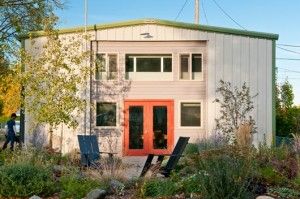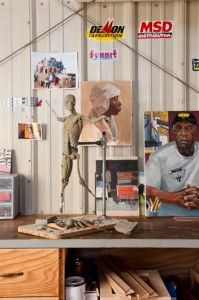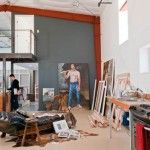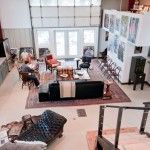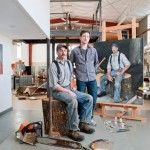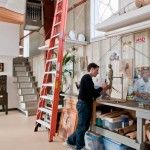Interview by Bonnie Gangelhoff, Photos by Audrey Hall
Describe your studio. It’s an industrial building made of steel that a guy once used to house a semi. When I bought it, it was set up like a mechanic’s shop. I put in wall of windows, a beautiful steel staircase, and modeled it after a New York loft.
What appeals to you about Livingston? Livingston has a grittiness that is left over from an older America. There are rail yards, lumberyards, and ranches. It’s a town on the cusp. It hasn’t embraced the character of other small towns, where the fabric of American life is becoming homogenized with Wal-Marts and Taco Bells. It’s a town that fits in with what I’m painting and commenting on about modern American life.
You have been on the road a bit over the past few years. How much time have you spent in Livingston? I set up the studio in 2009, lived in it for a year, and started a series of life-size paintings. You can’t do large-scale works on the road. I painted nudes, ranch hands, and loggers. I am drawn to portraiture. It has such a tradition in the aristocracy, and I like the idea of subverting it—painting people who otherwise wouldn’t be painted. In 2010 I went on the road. In the spring I went to Arizona and painted landscapes and some portraits of lettuce workers while I was renting a room from a Hispanic family in a border town. Then I followed some crews up to Salinas, CA. I just left a labor camp where I stayed in a dormitory-style bunk room with the Hispanic workers. I painted portraits of the workers, who were there to pick grapes and cherries. It’s really like the Dust Bowl in the 1930s, when the Okies and Middle America were moving west to California for jobs.
What were the workers’ reactions to you? I think at first they thought, ‘What is this gringo doing here?’ I don’t think they’d ever had a gringo living with them. I showed them a book with my paintings from all over the world. The hardest thing was getting that first guy to pose. But as people watched, they got more familiar with what I was doing. I paid the workers like models, at the standard rate by the hour. And I sent them copies of the paintings.
Before becoming an artist, you were in corporate finance on Wall Street. Why did you leave? I always had a side to me that wasn’t committed to it. I felt a lack of something. I felt like there was a way of relating to the world that was richer than I was experiencing. I didn’t grow up with any concept of what it is to be an artist. I grew up in a conservative environment, went to a prep school, and went to a good college. I went to art school on a whim. The idea started when I went to a figure drawing class with an artist and woman friend. She started bringing me along for fun.
Eventually you grew more serious about art. What then? I enrolled at Otis College of Art and Design in Los Angeles in 2001. The school has the building blocks of the visual arts. I needed to start somewhere. If I wanted to be an artist, I wanted to be trained like the modernists in the first half of the 20th century. I had done well on Wall Street, so I knew I could always go back and get a job. After Otis, I went back to New York and earned a master’s degree in fine art from the New York Academy of Art.
Was there a turning point in the direction of your art career? In the spring of 2006, I was living in New York and ready to give up painting. I had been painting for about a year and half in a Brooklyn studio with some well-known contemporary artists. I was making large-scale paintings that I thought would be part of the contemporary conversation. But suddenly I didn’t feel like my painting experience was anything different than my Wall Street experience. It wasn’t satisfying or what I was looking for. Then I got this unexpected invitation from the U.S. Ambassador to Algeria, a friend of the family. He asked me to come and paint in Algeria. The country had been closed to travel but had just opened up. The ambassador said he was trying to improve the Muslim view of the United States. I was supposed to go for six weeks, but I ended up staying for four months. I sat in remote mud huts, and as I was doing portraits, my whole life gelled. This was everything I was looking for. I was documenting something relevant. In Brooklyn I was feeling like the world really did not need another contemporary abstract painter.
What happened after your trip to Africa? I came back to the United States in 2007 and traveled around the country. I lived in my camper and painted coal miners in West Virginia and shrimpers in Louisiana. I wasn’t ready to go back to New York or Los Angeles. I spent my whole life in big cities, and I was interested in painting the changing American experience.
Why figures and portraits? I think what I am seeking out is humanity. Modern life has really isolated us from a sense of community. Communication isn’t about Facebook or texting, but sitting with people. For every meal while I was in Africa we ate out of one big bowl while sitting in a circle. There’s a difference between that and sitting with placemats around a dining room table. Painting from life while on the road gives me a connection to humanity. I’m drawn to developing relationships with the people I paint. I may sit with someone for five days. Something transpires. I once painted a coal miner. We got really close and talked about a lot of things. And he said to me at one point that it would normally take him a year or two to have the same connection we had in two weeks. It can be sad leaving these places and people.
You are writing a book. What is it about? I have kept a journal, and I want to summarize the last four years. I need about three solid months of time and space to write it. It’s about my journey, the people I encountered, and their stories. I want to publish the paintings of the people, too. The whole experience has been so rich.
What artwork do you keep in your studio? Works by one artist who I think is a genius—Neal Jones. He hasn’t been embraced by the art world yet.
If your studio was on fire, what one thing would you grab? My African paintings. While I was in southern Algeria, I was invited by a migrant worker from Niger to come and stay in his village. It was a once-in-a-lifetime experience. The village was in the middle of nowhere. I gave them some money and they built me a hut. I painted in sandstorms and lived under the harshest conditions. The paintings are irreplaceable and not replicable. I can’t make them again, and no one else is likely to go to my village.
What impresses you about other artists’ works? Vibrancy and the unexpected.
What’s the most memorable experience you’ve had? Living with the Tuaregs in Africa and the coal miners in West Virginia.
What is the most rewarding thing about your work? The connection I make with people is the most satisfying thing, and honoring people who don’t get honored.
Describe yourself in one word. Sincere.
People would be surprised to learn that… I worked on Wall Street.
When you are not painting, what do you enjoy doing? Hiking and writing.
What is the one place people will never find you? A spa.
When people visit Montana, where do you like to take them? Hiking in the Beartooth Mountains and to the rodeo.
Representation
www.hugh-wilson.com
Featured in “My World” in January 2011.






